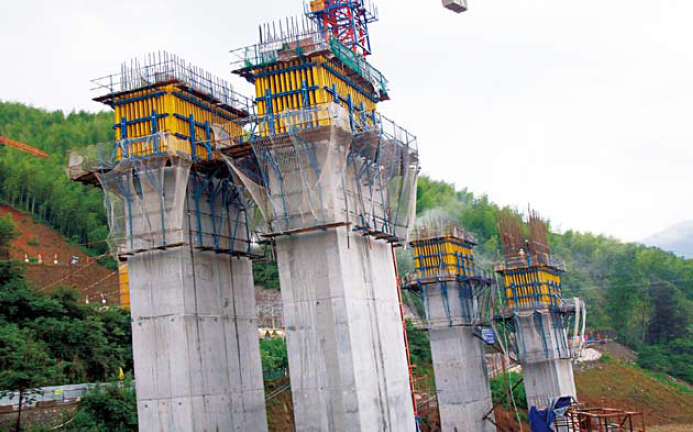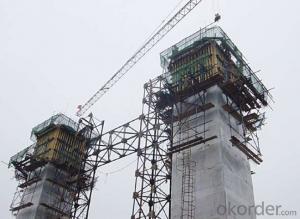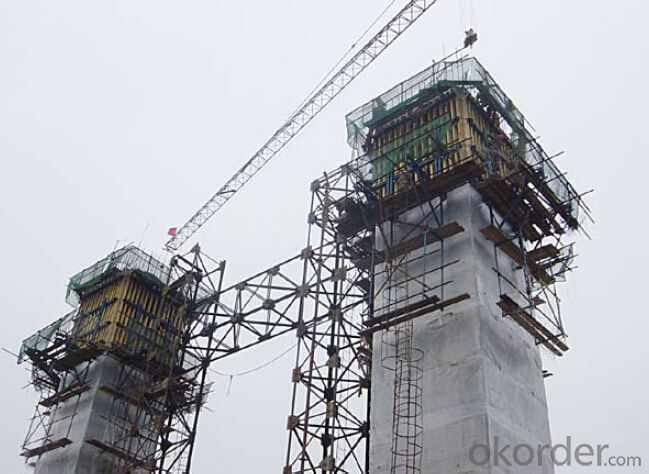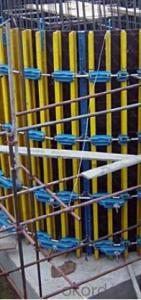Climbing Bracket for Formwork and Scaffolding Build
- Loading Port:
- Tianjin
- Payment Terms:
- TT OR LC
- Min Order Qty:
- 50 m²
- Supply Capability:
- 1000 m²/month
OKorder Service Pledge
OKorder Financial Service
You Might Also Like
Climbing Bracket CB240 & CB210
They are framework brackets for supporting large-area wall formwork.
Typical applications for the CB240&CB210 are pier and column/shear wall/core walll/ in the
building.
CB210 has smaller size than CB240, it will be cost effective in some condition.
Characteristics:
◆ High bearing capacity
The high loading capacity of the brackets allow very large scaffold units. This saves the number
anchor points required as well as reducing climbing times.
◆ Simple moving procedure by crane
Through the strong connection of formwork together with the climbing scaffold, both can be moved
as a single climbing unit by crane. Thus valuable time-savings can be achieved.
◆ Fast striking process without a crane
With the retrusive set, large formwork elements can also be retracted quickly and a minimum of
effort.
◆ Safe with work platform
The platforms have assembled firmly with bracket and will be climbing together, without scaffolding
but can work safely in spite of your high location.


- Q: Can steel formwork be used for high-rise buildings?
- Yes, steel formwork can be used for high-rise buildings. Steel formwork is known for its durability, strength, and ability to withstand high concrete pressures. These characteristics make it suitable for constructing tall structures such as high-rise buildings. Steel formwork systems are designed to provide stability and support during the construction process, ensuring that the concrete is properly shaped and cured. Additionally, steel formwork can be easily assembled and disassembled, allowing for efficient construction and adaptability to different project requirements. Overall, steel formwork is a reliable and commonly used solution for high-rise building construction.
- Q: Can steel formwork be used for both straight and curved walls?
- Yes, steel formwork can be used for both straight and curved walls.
- Q: What are the common challenges faced when using steel formwork?
- There are several common challenges faced when using steel formwork in construction projects. One of the main challenges is the cost. Steel formwork can be more expensive compared to other types of formwork materials such as wood or plastic. This can make it less accessible for smaller construction projects or those with tight budgets. Another challenge is the weight of steel formwork. Steel is a heavy material, which can make it difficult to handle and transport on the construction site. It requires specialized equipment and manpower to move and assemble the formwork, which can add to the overall project costs. Steel formwork also requires skilled labor for its installation and dismantling. The assembly process can be complex, and if not done properly, it can lead to inaccuracies in the concrete structure. This requires experienced workers who are familiar with steel formwork systems and have the necessary expertise to ensure the formwork is properly aligned and secured. Additionally, steel formwork requires regular maintenance and cleaning to ensure its longevity. Steel is susceptible to rust and corrosion, especially when exposed to moisture or chemicals. This means that the formwork needs to be regularly inspected, repaired, and protected to prevent any degradation or structural issues. Lastly, steel formwork is not as versatile as other types of formwork. It is typically used for repetitive and standardized construction projects, where the same formwork configuration is required repeatedly. Customization and flexibility can be limited with steel formwork, which can be a challenge for projects that require unique or intricate designs. Despite these challenges, steel formwork also offers several advantages such as its durability, strength, and reusability. It provides a sturdy and stable structure for pouring concrete, allowing for faster construction times and improved quality. However, it is important to carefully consider the specific requirements and constraints of a construction project before deciding to use steel formwork.
- Q: What are the different types of ties used with steel formwork?
- There are several different types of ties used with steel formwork, depending on the specific requirements of the construction project. Some of the commonly used types of ties include: 1. Snap Ties: These are the most basic and widely used type of ties. They consist of two parts, a rod and a flat plate, which are connected together using a snap tie wedge. Snap ties are typically used for straight walls and provide a secure connection between the formwork panels. 2. Coil Ties: Coil ties are similar to snap ties, but they have a more flexible design. They consist of a rod with a coil at one end and a flat plate at the other. The coil allows for easy installation and removal of the tie, making it suitable for curved or irregularly shaped walls. 3. She-Bolts: She-bolts are used for connecting steel formwork panels together. They are threaded rods with a flat plate at one end and a nut at the other. She-bolts provide a strong connection and are commonly used for large formwork panels or when high loads need to be supported. 4. Tie Rods: Tie rods are used for securing formwork panels together. They consist of long threaded rods that pass through the formwork panels and are secured with nuts and washers on both ends. Tie rods are commonly used in conjunction with other types of ties to provide additional support and stability to the formwork system. 5. Wing Nuts: Wing nuts are used in combination with tie rods to secure the formwork panels in place. They have a wing-like design that allows for easy tightening and loosening by hand, without the need for additional tools. Wing nuts are commonly used in vertical formwork applications. 6. Cone Anchors: Cone anchors are used to secure the formwork system to the concrete structure. They consist of a cone-shaped anchor with a threaded rod, which is inserted into a pre-drilled hole in the concrete. Cone anchors provide a strong and reliable connection between the formwork and the concrete. These are just a few examples of the different types of ties used with steel formwork. The selection of the appropriate tie depends on factors such as the shape and size of the formwork, the load requirements, and the specific construction project. It is important to consult with a structural engineer or formwork expert to determine the most suitable tie system for a particular application.
- Q: What is steel formwork?
- Steel formwork is a type of temporary structure made from steel that is used in construction projects to create the desired shape and structure of concrete elements such as walls, columns, and slabs. It provides a strong and durable framework for the concrete during the pouring and curing process, ensuring accuracy and stability in the final structure.
- Q: What are the considerations when designing a steel formwork system?
- When designing a steel formwork system, several considerations need to be taken into account. Firstly, the desired shape and dimensions of the concrete structure need to be carefully planned. This includes considering the load-bearing capacity, stability, and rigidity requirements of the formwork system. Secondly, the choice of steel material is crucial. The steel should have high tensile strength, durability, and resistance to corrosion and wear. Additionally, factors such as weight, ease of handling, and reusability should be considered to optimize the formwork system's efficiency and cost-effectiveness. Furthermore, the formwork system should be designed to allow for easy assembly, disassembly, and adjustments on-site. Components such as panels, beams, props, and connectors should be designed for quick and secure installation, ensuring efficient construction processes. Safety is another critical consideration. The formwork system needs to be designed to withstand the forces and pressures exerted by wet concrete, preventing any collapse or failure during the pouring and curing stages. Proper bracing, tie systems, and anchorage points should be incorporated to ensure the stability and safety of the entire structure. Lastly, environmental factors should be taken into consideration. The formwork system should consider factors such as noise and vibration reduction, waste management, and the use of sustainable materials and practices to minimize the impact on the surrounding environment. Overall, a well-designed steel formwork system should address structural requirements, material properties, ease of use, safety, and sustainability to ensure successful and efficient concrete construction projects.
- Q: How does steel formwork affect the overall construction site dust control?
- Steel formwork can significantly improve dust control on a construction site. Its solid structure and smooth surface minimize the release of dust particles, reducing the potential for airborne dust. Additionally, steel formwork can be easily cleaned and maintained, further limiting dust accumulation. Overall, using steel formwork helps create a cleaner and healthier environment for workers and minimizes the need for additional dust control measures.
- Q: What are the characteristics of steel formwork
- 3, the template adsorption force is small, easy demoulding.4, the number of turnover, generally can be used 50 times.
- Q: How does steel formwork affect the overall safety of a building project?
- Steel formwork can greatly enhance the overall safety of a building project due to its durability, strength, and stability. It provides a solid and secure framework for concrete placement, ensuring proper alignment and support during the construction process. This reduces the risk of structural failures, collapses, or accidents, thereby enhancing the safety of workers and the overall project. Additionally, steel formwork is fire-resistant, which further contributes to the safety of the building as it can withstand high temperatures and prevent the spread of fire.
- Q: Are there any specific design considerations for steel formwork systems?
- Yes, there are several specific design considerations for steel formwork systems. Firstly, the design of steel formwork systems should consider the load-bearing capacity of the structure. Steel formwork systems should be designed to withstand the weight of the concrete being poured, as well as any additional loads such as workers or construction equipment. The design should ensure that the steel formwork is strong enough to support these loads without any deformation or failure. Secondly, the design of steel formwork systems should take into account the dimensional accuracy and stability requirements of the concrete structure. Steel formwork systems need to be designed with precision and accuracy to ensure that the final concrete structure meets the desired specifications. The formwork should be rigid and stable, preventing any movement or shifting during the concrete pouring and curing process. Additionally, the design of steel formwork systems should consider the ease of assembly, disassembly, and reusability. Steel formwork systems are typically assembled and disassembled multiple times throughout a construction project. Therefore, the design should allow for easy and efficient installation and removal, minimizing downtime and labor costs. Furthermore, the steel formwork should be durable and reusable, reducing the need for frequent replacement and contributing to cost savings. Lastly, the design of steel formwork systems should consider safety aspects. The formwork should be designed to provide a safe working environment for construction workers. This includes features such as non-slip surfaces, guardrails, and safety barriers to prevent falls or accidents. The design should also incorporate proper access and egress points, ensuring easy movement for workers within the formwork system. In summary, specific design considerations for steel formwork systems include load-bearing capacity, dimensional accuracy, ease of assembly and reusability, and safety features. By taking these factors into account, designers can ensure the successful and efficient construction of concrete structures using steel formwork systems.
Send your message to us
Climbing Bracket for Formwork and Scaffolding Build
- Loading Port:
- Tianjin
- Payment Terms:
- TT OR LC
- Min Order Qty:
- 50 m²
- Supply Capability:
- 1000 m²/month
OKorder Service Pledge
OKorder Financial Service
Similar products
Hot products
Hot Searches


















